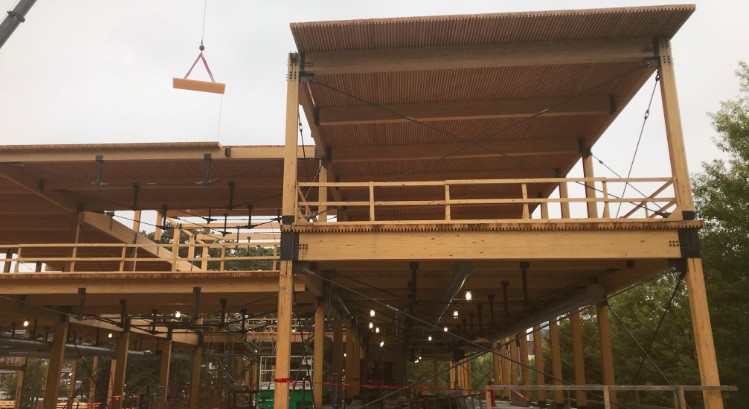This is one of five major green building trends we’ve identified for 2019. To explore more of them, check out our Five green building trends for 2019 cover story.
Mass timber has grown into the go-to structural material for green mid-rises. It’s about to sprout even higher.
Aside from its aesthetic values, wood has an enormous environmental edge over steel and concrete: To be fashioned into a structural material, it requires less than one-quarter the carbon emissions of either of those alternatives. This is mainly because wood is a carbon sink; trees draw carbon out of the atmosphere and store it as they grow.
The environmental benefits — along with improvements in the fabrication of glue-laminated and cross-laminated timbers and panels — have driven a mass timber movement that’s spread in recent years from the Pacific Northwest eastward. The capacity of manufacturers that produce engineering-wood structural components has ramped up as well. Just last year, the first cross-laminated timber plant in the Southeast opened in Dothan, Ala.
Building codes that favor concrete and steel continue to limit broader adoption of mass timber. Restrictions on the use of wood date back to building and fire codes that swept across the nation following the Great Chicago Fire of 1871. Currently, the International Building Code restricts occupiable space in “heavy timber” above 85 feet above street level, forcing those who aspire to new heights to seek exemptions.
That’s about to change.
In January, after years of advocacy from wood industry and green-building advocates, the International Code Council voted to loosen the IBC’s restrictions on structural wood. The advocates’ arguments? Sprinklers, compartmentalization and other modern fireproofing techniques have greatly reduced risk. And a growing body of research is showing that mass timber is actually much more resistant than to fire than is two-by-four framing. The new IBC, which bases its mass timber rules on performance-based risk assessment rather than prescriptions, will soon allow mass timber structures up to 18 stories tall.
The new model code doesn’t go into effect until 2021, which means that many local codes won’t follow through with their own updates until well into the next decade. But anticipation of the change is likely to give the mass timber movement more momentum. According to the Woodworks, 177 mass timber buildings have been completed in the United States in recent years or are under construction, while another 310 are in the design phase. Look for substantially more mass timber buildings and plant expansions this year.
Signs of this new momentum already abound. The venture capital funded, design-manufacturing-construction firm Katerra plans to open high-tech plants in California and Washington this year.
An even stronger hint that the sky’s the limit for mass timber can be found in Europe, where codes already have been modernized. In Norway, for instance, the world’s tallest wood-structure tower is slated for completion in March 2019; and just a few months later, the second-tallest should be be completed in Austria.
PHOTO AT TOP: The Kendeda Building for Innovative Sustainable Design at Georgia Tech is one of handful of mass timber buildings under construction in the Southeast. Photo by Ken Edelstein.
The Kendeda Living Building Chronicle reports on regenerative design and construction, which a special focus on the Kendeda Building for Innovative Design and Construction. To explore more of our Five Green Building Trends for 2019, click here.


